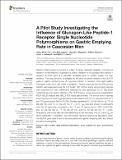Files in this item
A pilot study investigating the influence of glucagon-like peptide-1 receptor single nucleotide polymorphisms on gastric emptying rate in Caucasian Men
Item metadata
| dc.contributor.author | Yau, Adora M. W. | |
| dc.contributor.author | McLaughlin, John | |
| dc.contributor.author | Maughan, Ronald J. | |
| dc.contributor.author | Gilmore, William | |
| dc.contributor.author | Ashworth, Jason J. | |
| dc.contributor.author | Evans, Gethin H. | |
| dc.date.accessioned | 2018-10-10T14:30:13Z | |
| dc.date.available | 2018-10-10T14:30:13Z | |
| dc.date.issued | 2018-09-25 | |
| dc.identifier | 256162499 | |
| dc.identifier | a6f9d4c7-e781-4c4c-b637-b29e6868c468 | |
| dc.identifier | 85055203227 | |
| dc.identifier | 000445632500001 | |
| dc.identifier.citation | Yau , A M W , McLaughlin , J , Maughan , R J , Gilmore , W , Ashworth , J J & Evans , G H 2018 , ' A pilot study investigating the influence of glucagon-like peptide-1 receptor single nucleotide polymorphisms on gastric emptying rate in Caucasian Men ' , Frontiers in Physiology , vol. 9 , 1331 . https://doi.org/10.3389/fphys.2018.01331 | en |
| dc.identifier.issn | 1664-042X | |
| dc.identifier.other | RIS: urn:19D09587A9561F0BB3FC9F76D9335A7B | |
| dc.identifier.uri | https://hdl.handle.net/10023/16179 | |
| dc.description | AY was supported by a Manchester Metropolitan University Ph.D. studentship. | en |
| dc.description.abstract | Gastric emptying rate in humans is subject to large individual variability, but previous research on the influence of genetics is scarce. Variation in the glucagon-like peptide-1 receptor (GLP1R) gene is a plausible candidate gene to partially explain the high variance. This study aimed to investigate the influence of genetic variation in the GLP1R gene on gastric emptying rate of a glucose solution in humans. Forty eight healthy Caucasian males took part in this investigation. Gastric emptying rate of a 6% glucose solution was assessed using the 13C breath test method and a venous blood sample was obtained from each participant. Participants were genotyped for twenty-seven Tag single nucleotide polymorphisms (SNPs) in the GLP1R locus using Sequenom MassARRAY iPLEX GOLD analysis and MALDI-TOF mass spectrometry. The time at which maximal emptying rate occurred (Tlag) was faster in participants with the CC genotype than in TT and TC genotypes for SNP rs742764: (Median (quartiles) CC, 35 (30-36) min vs. TT, 43 (39-46) min and TC, 41 (39-45) min; P <0.01). Tlag was also slower in participants with the AA genotype compared to the TT and TA genotypes for SNP rs2254336: (AA, 43 (39-49) min vs. TT, 36 (34-41) min and TA, 39 (35-42) min; P <0.05). Analysis by phenotype also showed differences in half-emptying time (T½) and Tlag for SNPs rs9283907, rs2268657 and rs2254336. Several neighbouring Tag SNPs within the GLP1R gene were found to be associated with gastric emptying rate, and should be further investigated. | |
| dc.format.extent | 184386 | |
| dc.language.iso | eng | |
| dc.relation.ispartof | Frontiers in Physiology | en |
| dc.subject | GLP-1 receptor | en |
| dc.subject | Single nucleotide polymorphism | en |
| dc.subject | Gastric emptying rate | en |
| dc.subject | GLP-1 | en |
| dc.subject | Gastrointestinal motility | en |
| dc.subject | RZ Other systems of medicine | en |
| dc.subject | NDAS | en |
| dc.subject.lcc | RZ | en |
| dc.title | A pilot study investigating the influence of glucagon-like peptide-1 receptor single nucleotide polymorphisms on gastric emptying rate in Caucasian Men | en |
| dc.type | Journal article | en |
| dc.contributor.institution | University of St Andrews. School of Medicine | en |
| dc.identifier.doi | 10.3389/fphys.2018.01331 | |
| dc.description.status | Peer reviewed | en |
This item appears in the following Collection(s)
Items in the St Andrews Research Repository are protected by copyright, with all rights reserved, unless otherwise indicated.

